Does Standing Up Enhance Performance on the Stroop Task in Healthy Young Adults? A Systematic Review and Meta-Analysis
Abstract
1. Introduction
2. Methods
- Population: healthy adults
- Intervention: word-color Stroop task
- Comparison: sitting vs. standing posture
- Outcome measures: Stroop task performance (reaction times)
- Study design: crossover randomized controlled trials
2.1. Search Strategy
2.2. Selection Criteria
2.3. Data Extraction and Statistical Analysis
3. Results
3.1. Study Selection
3.2. Characteristics of Included Studies
3.3. Meta-Analysis Outcomes
4. Discussion
5. Conclusions
Author Contributions
Funding
Institutional Review Board Statement
Informed Consent Statement
Data Availability Statement
Acknowledgments
Conflicts of Interest
Appendix A
| Item | Details |
|---|---|
| Keywords used | (“stroop” OR “cognitive control” OR “executive control” OR “executive function” OR “cognitive flexibility” OR “working memory” OR “response inhibition”) AND (“posture” OR “sit” OR “sitting” OR “sitting position” OR “sit-to-stand” OR “sit-stand” OR “stand” OR “standing” OR “standing position” OR “upright” OR “uprightness” OR “work desk” OR “workstation”) |
| Databases | Academic Search Complete, CINAHL Ultimate, MEDLINE, PubMed, Web of Science |
| Time filter | Accessible/published articles until 31 December 2022 |
| Language | English |
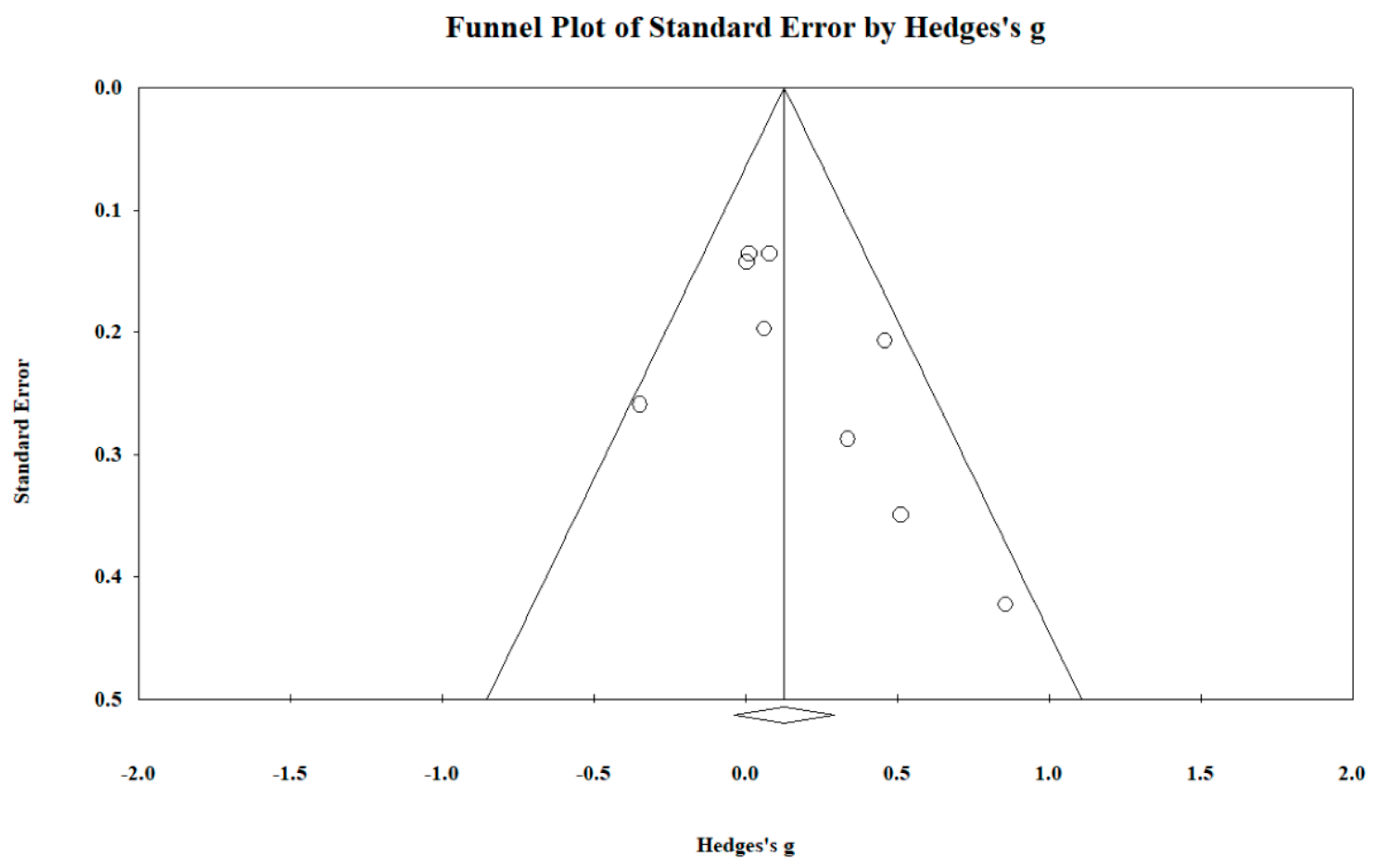
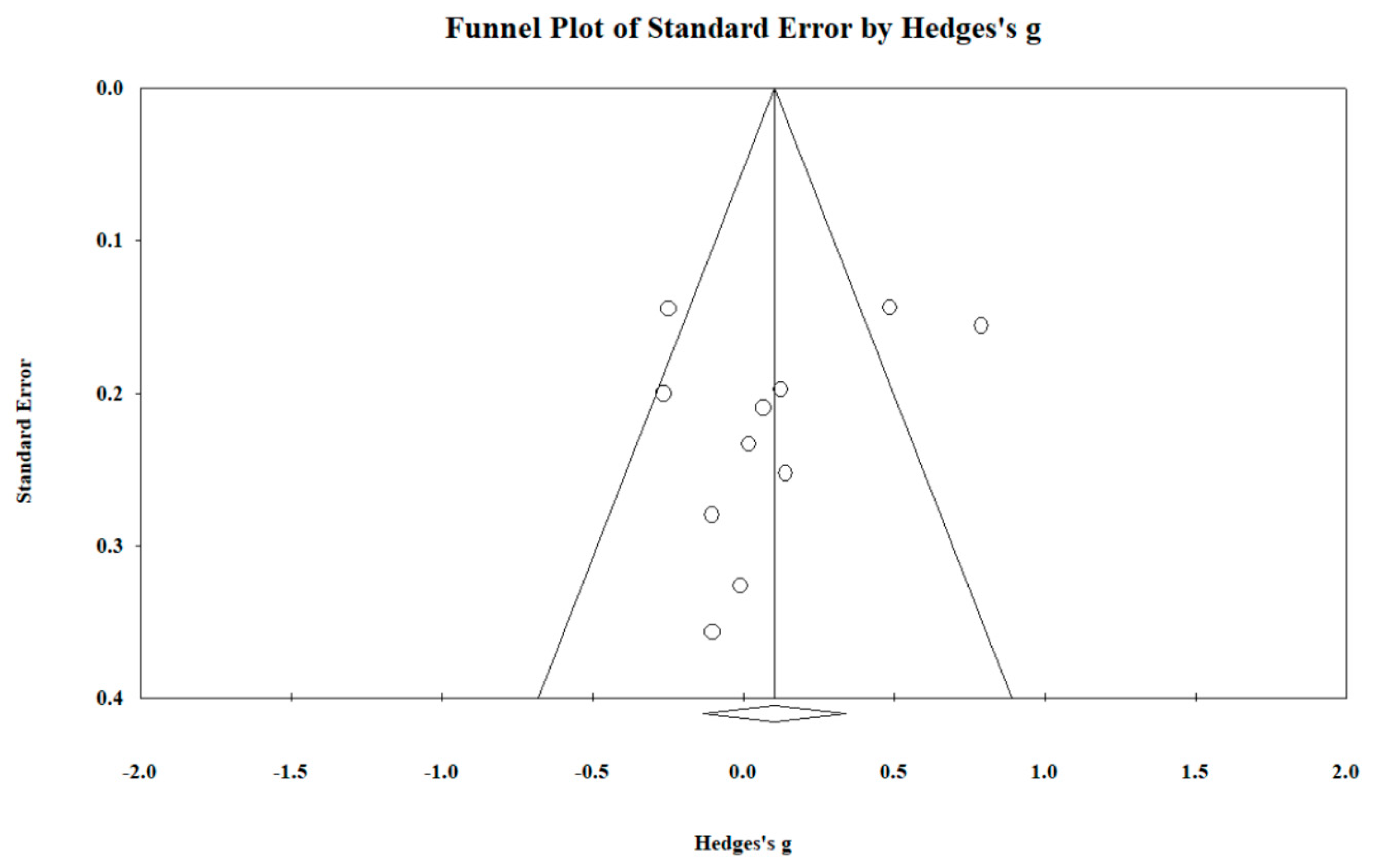
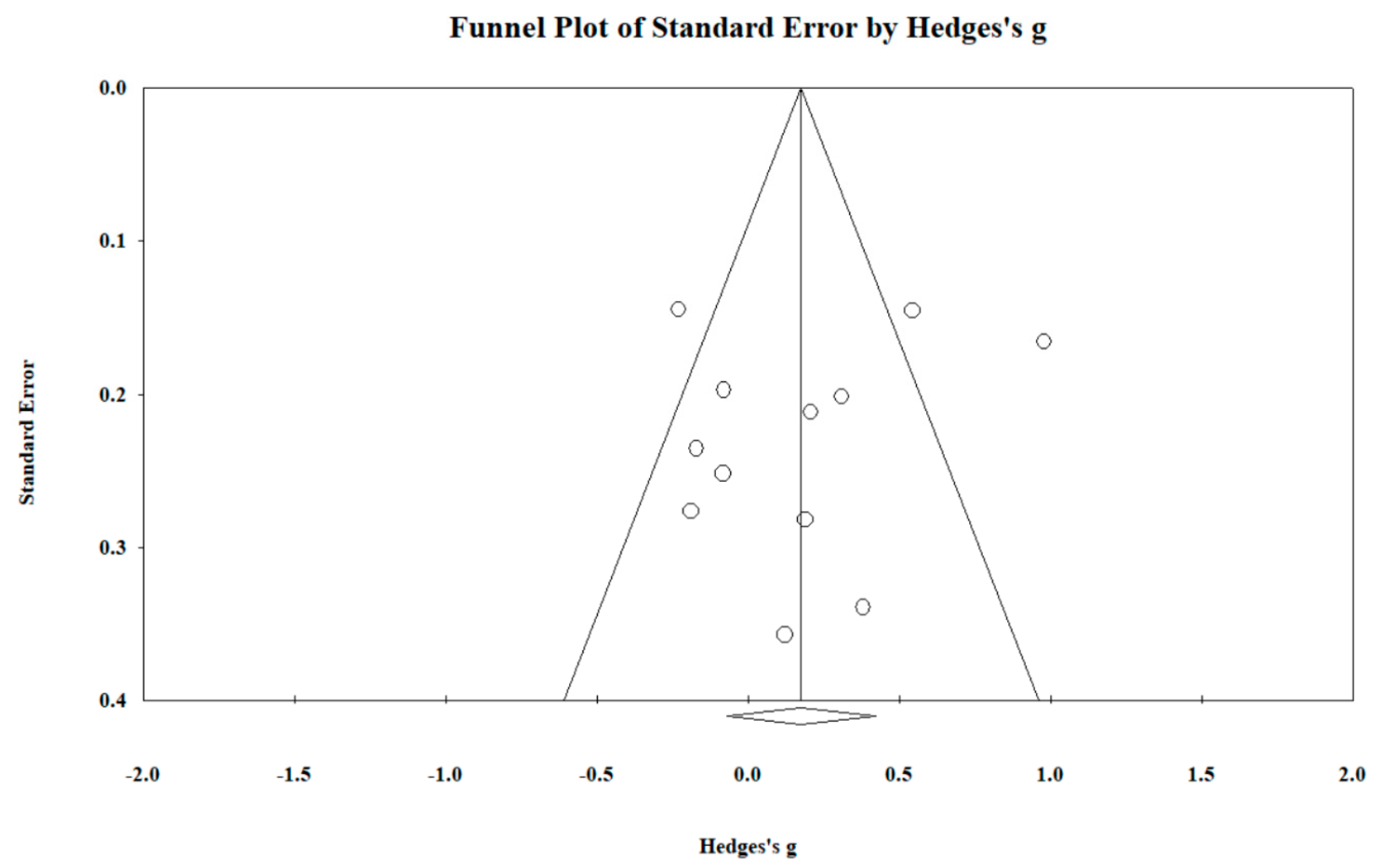
References
- Faulkner, K.A.; Redfern, M.S.; Cauley, J.A.; Landsittel, D.P.; Studenski, S.A.; Rosano, C.; Simonsick, E.M.; Harris, T.B.; Shorr, R.I.; Ayonayon, H.N.; et al. Multitasking: Association between poorer performance and a history of recurrent falls. J. Am. Geriatr. Soc. 2007, 55, 570–576. [Google Scholar] [CrossRef] [PubMed]
- Marusic, U.; Taube, W.; Morrison, S.; Biasutti, L.; Grassi, B.; De Pauw, K.; Meeusen, R.; Pisot, R.; Ruffieux, J. Aging effects on prefrontal cortex oxygenation in a posture-cognition dual-task: An fnirs pilot study. Eur. Rev. Aging Phys. Act. 2019, 16, 2. [Google Scholar] [CrossRef] [PubMed]
- Chambers, A.J.; Robertson, M.M.; Baker, N.A. The effect of sit-stand desks on office worker behavioral and health outcomes: A scoping review. Appl. Ergon. 2019, 78, 37–53. [Google Scholar] [CrossRef] [PubMed]
- Church, T.S.; Thomas, D.M.; Tudor-Locke, C.; Katzmarzyk, P.T.; Earnest, C.P.; Rodarte, R.Q.; Martin, C.K.; Blair, S.N.; Bouchard, C. Trends over 5 decades in U.S. occupation-related physical activity and their associations with obesity. PLoS ONE 2011, 6, e19657. [Google Scholar] [CrossRef] [PubMed]
- Carr, L.J.; Karvinen, K.; Peavler, M.; Smith, R.; Cangelosi, K. Multicomponent intervention to reduce daily sedentary time: A randomised controlled trial. BMJ Open 2013, 2, e003261. [Google Scholar] [CrossRef]
- Koepp, G.A.; Manohar, C.U.; McCrady-Spitzer, S.K.; Ben-Ner, A.; Hamann, D.J.; Runge, C.F.; Levine, J.A. Treadmill desks: A 1-year prospective trial. Obesity 2013, 21, 705–711. [Google Scholar] [CrossRef]
- Blyth, F.M.; March, L.M.; Nicholas, M.K.; Cousins, M.J. Chronic pain, work performance and litigation. Pain 2013, 103, 41–47. [Google Scholar] [CrossRef]
- Rasmussen, C.D.N.; Holtermann, A.; Jørgensen, M.B.; Ørberg, A.; Mortensen, O.S.; Søgaard, K. A multi-faceted workplace intervention targeting low back pain was effective for physical work demands and maladaptive pain behaviours, but not for work ability and sickness absence: Stepped wedge cluster randomised trial. Scand. J. Public Health 2016, 44, 560–570. [Google Scholar] [CrossRef]
- Bantoft, C.; Summers, M.J.; Tranent, P.; Palmer, M.A.; Cooley, P.D.; Pedersen, S.J. Effect of standing or walking at a workstation on cognitive function: A randomized counterbalanced trial. Hum. Factors 2016, 58, 140–149. [Google Scholar] [CrossRef]
- Roerdink, M.; Hlavackova, P.; Vuillerme, N. Center-of-pressure regularity as a marker for attentional investment in postural control: A comparison between sitting and standing postures. Hum. Mov. Sci. 2011, 30, 203–212. [Google Scholar] [CrossRef]
- Schraefel, M.C.; Kenneth, J.; Andersen, L.L. Assessing the effect of self-positioning on cognitive executive function. J. Ergon. 2012, 2, 110. [Google Scholar] [CrossRef]
- Kang, S.H.; Lee, J.; Jin, S. Effect of standing desk use on cognitive performance and physical workload while engaged with high cognitive demand tasks. Appl. Ergon. 2021, 92, 103306. [Google Scholar] [CrossRef] [PubMed]
- Smith, K.C.; Davoli, C.C.; Knapp, W.H.; Abrams, R.A. Standing enhances cognitive control and alters visual search. Atten. Percept. Psychophys. 2019, 81, 2320–2329. [Google Scholar] [CrossRef] [PubMed]
- Liu, C.; Liao, J. Stand up to action: The postural effect of moral dilemma decision-making and the moderating role of dual processes. PsyCh J. 2019, 10, 587–597. [Google Scholar] [CrossRef]
- Russell, B.A.; Summers, M.J.; Tranent, P.; Palmer, M.A.; Cooley, P.D.; Pedersen, S.J. A randomised control trial of the cognitive effects of working in a seated as opposed to a standing position in office workers. Ergonomics 2016, 59, 737–744. [Google Scholar] [CrossRef]
- Schwartz, B.; Kapellusch, J.M.; Schrempf, A.; Probst, K.; Haller, M.; Baca, A. Effect of alternating postures on cognitive performance for healthy people performing sedentary work. Ergonomics 2018, 61, 778–795. [Google Scholar] [CrossRef]
- Vuillerme, N.; Nougier, V.; Teasdale, N. Effects of a reaction time task on postural control in humans. Neurosci. Lett. 2000, 291, 77–80. [Google Scholar] [CrossRef]
- Husemann, B.; Von Mach, C.Y.; Borsotto, D.; Zepf, K.I.; Scharnbacher, J. Comparisons of musculoskeletal complaints and data entry between a sitting and a sit-stand workstation paradigm. Hum. Factors 2009, 51, 310–320. [Google Scholar] [CrossRef]
- Rostami, M.; Razeghi, M.; Daneshmandi, H.; Hassanzadeh, J.; Choobineh, A. Cognitive and skill performance of individuals at sitting versus standing workstations: A quasi-experimental study. Int. J. Occup. Saf. Ergon. 2020, 28, 544–554. [Google Scholar] [CrossRef]
- Diamond, A. Executive functions. Annu. Rev. Psychol. 2013, 64, 135–168. [Google Scholar] [CrossRef]
- MacLoad, C.M. Half a century of research on the Stroop effect: An integrative review. Psychol. Bull. 1991, 109, 163–203. [Google Scholar] [CrossRef] [PubMed]
- Egeth, H.E.; Blecker, D.L.; Kamlet, A.S. Verbal interference in a perceptual comparison task. Percept. Psychophys. 1969, 6, 355–356. [Google Scholar] [CrossRef]
- Owen, A.M.; McMillan, K.M.; Laird, A.R.; Bullmore, E. N-back working memory paradigm: A meta-analysis of normative functional neuroimaging studies. Hum. Brain Mapp. 2005, 25, 46–59. [Google Scholar] [CrossRef] [PubMed]
- Meule, A. Reporting and interpreting task performance in go/no-go affective shifting tasks. Front. Psychol. 2005, 8, 701. [Google Scholar] [CrossRef]
- Lu, C.H.; Proctor, R.W. The influence of irrelevant location information on performance: A review of the simon and spatial stroop effects. Psychon. Bull. Rev. 1995, 2, 174–207. [Google Scholar] [CrossRef] [PubMed]
- Eriksen, B.A.; Eriksen, C.W. Effects of noise letters upon the identification of a target letter in a nonsearch task. Percept. Psychophys. 1974, 16, 143–149. [Google Scholar] [CrossRef]
- Kaufman, J.N.; Ross, T.J.; Stein, E.A.; Garavan, H. Cingulate hypoactivity in cocaine users during a go-nogo task as revealed by event-related functional magnetic resonance imaging. J. Neurosci. 2003, 23, 7839–7843. [Google Scholar] [CrossRef]
- Rosenbaum, D.; Mama, Y.; Algom, D. Stand by your stroop: Standing up enhances selective attention and cognitive control. Psychol. Sci. 2017, 28, 1864–1867. [Google Scholar] [CrossRef]
- Caron, E.E.; Reynolds, M.G.; Ralph, B.C.W.; Carriere, J.S.A.; Besner, D.; Smilek, D. Does posture influence the stroop effect? Psychol. Sci. 2020, 31, 1452–1460. [Google Scholar] [CrossRef]
- Straub, E.R.; Dames, H.; Kiesel, A.; Dignath, D. Does body posture reduce the stroop effect? evidence from two conceptual replications and a meta-analysis. Acta Psychol. 2022, 224, 103497. [Google Scholar] [CrossRef]
- Page, M.J.; McKenzie, J.E.; Bossuyt, P.M.; Boutron, I.; Hoffmann, T.C.; Mulrow, C.D.; Shamseer, L.; Tetzlaff, J.M.; Akl, E.A.; Brennan, S.E.; et al. The PRISMA 2020 statement: An updated guideline for reporting systematic reviews. BMJ 2021, 372, n17. [Google Scholar] [CrossRef]
- Richardson, W.S.; Wilson, M.C.; Nishikawa, J.; Hayward, R.S. The well-built clinical question: A key to evidence-based decisions. ACP J. Club 1995, 123, A12–A13. [Google Scholar] [CrossRef] [PubMed]
- Eriksen, M.B.; Frandsen, T.F. The impact of patient, intervention, comparison, outcome (PICO) as a search strategy tool on literature search quality: A systematic review. J. Med. Libr. Assoc. 2018, 106, 420–431. [Google Scholar] [CrossRef] [PubMed]
- Amir-Behghadami, M.; Janati, A. Population, intervention, comparison, outcomes and study (PICOS) design as a framework to formulate eligibility criteria in systematic reviews. Emerg. Med. J. 2020, 37, 387. [Google Scholar] [CrossRef] [PubMed]
- Kmet, L.M.; Lee, R.C.; Cook, L.S. Standard Quality Assessment Criteria for Evaluating Primary Research Papers from a Variety of Fields; Alberta Heritage Foundation for Medical Research (AHFMR): Alberta, CA, USA, 2004. [Google Scholar]
- Zhang, Z.; Zhang, B.; Cao, C.; Chen, W. The effects of using an active workstation on executive function in chinese college students. PLoS ONE 2018, 13, e0197740. [Google Scholar] [CrossRef]
- Pinho, J.P.; Azevedo, A.P.S.; Serrão, J.C.; Forner-Cordero, A.; Amadio, A.C.; Mezêncio, B. Aging effects of haptic input on postural control under a dual-task paradigm. Exp. Gerontol. 2022, 168, 111928. [Google Scholar] [CrossRef]
- Hedges, L.; Olkin, I. Statistical Methods for Meta-Analysis; Academic Press: Cambridge, MA, USA, 1985. [Google Scholar]
- Higgins, J.P.; Thompson, S.G.; Deeks, J.J.; Altman, D.G. Measuring inconsistency in meta-analyses. BMJ 2003, 37, 387. [Google Scholar] [CrossRef]
- Schmidt, R.F.; Lang, F.; Heckmann, M. (Eds.) Lehmann-Horn FMotor Systems. In Human Physiology and Pathophysiology; Springer: Berlin/Heidelberg, Germany, 2011; pp. 127–160. [Google Scholar]
- Passingham, R.E. Attention to action. Philos. Trans. R. Soc. Lond. Ser. B Biol. Sci. 1996, 351, 1473–1479. [Google Scholar] [CrossRef]
- Colcombe, S.J.; Erickson, K.I.; Scalf, P.E.; Kim, J.S.; Prakash, R.; McAuley, E.; Elavsky, S.; Marquez, D.X.; Hu, L.; Kramer, A.F. Aerobic exercise training increases brain volume in aging humans. J. Gerontol. Ser. A Biol. Sci. Med. Sci. 2006, 61, 1166–1170. [Google Scholar] [CrossRef]
- Lacour, M.; Bernard-Demanze, L.; Dumitrescu, M. Posture control, aging, and attention resources: Models and posture-analysis methods. Clin. Neurophysiol. 2008, 38, 411–421. [Google Scholar] [CrossRef]
- Marusic, U.; Müller, M.L.T.M.; Alexander, N.B.; Bohnen, N.I. Feasibility and behavioral effects of prolonged static and dynamic standing as compared to sitting in older adults with type 2 diabetes mellitus. BMC Geriatr. 2020, 20, 204. [Google Scholar] [CrossRef] [PubMed]
- Zeng, Q.; Qi, S.; Li, M.; Yao, S.; Ding, C.; Yang, D. Enhanced conflict-driven cognitive control by emotional arousal, not by valence. Cogn. Emot. 2017, 31, 1083–1096. [Google Scholar] [CrossRef] [PubMed]
- Brown, W.J.; Miller, Y.D.; Miller, R. Sitting time and work patterns as indicators of overweight and obesity in australian adults. Int. J. Obes. 2003, 27, 1340–1346. [Google Scholar] [CrossRef]
- Healy, G.N.; Eakin, E.; LaMontagne, A.D.; Owen, N.; Winkler, E.A.; Wiesner, G.; Gunning, L.; Neuhaus, M.; Lawler, S.; Fjeldsoe, B.S.; et al. Reducing sitting time in office workers: Short-term efficacy of a multicomponent intervention. Prev. Med. 2013, 57, 43–48. [Google Scholar] [CrossRef]
- Peddie, M.C.; Bone, J.L.; Rehrer, N.J.; Skeaff, C.M.; Gray, A.R.; Perry, T.L. Breaking prolonged sitting reduces postprandial glycemia in healthy, normal-weight adults: A randomized crossover trial. Am. J. Clin. Nutr. 2013, 98, 358–366. [Google Scholar] [CrossRef] [PubMed]
- Dietrich, A.; Audiffren, M. The reticular-activating hypofrontality (rah) model of acute exercise. Neurosci. Biobehav. Rev. 2011, 35, 1305–1325. [Google Scholar] [CrossRef]
- Shumway-Cook, A.; Woollacott, M.; Kerns, K.A.; Baldwin, M. The effects of two types of cognitive tasks on postural stability in older adults with and without a history of falls. J. Gerontol. Ser. A Biol. Sci. Med. Sci. 1997, 52, M232–M240. [Google Scholar] [CrossRef]
- Bloem, B.R.; Valkenburg, V.V.; Slabbekoorn, M.; Willemsen, M.D. The multiple tasks test: Development and normal strategies. Gait Posture 2001, 14, 191–202. [Google Scholar] [CrossRef]
- Gérin-Lajoie, M.; Richards, C.L.; McFadyen, B.J. The circumvention of obstacles during walking in different environmental contexts: A comparison between older and younger adults. Gait Posture 2006, 24, 364–369. [Google Scholar] [CrossRef]
- Canning, C.G. The effect of directing attention during walking under dual-task conditions in parkinson’s disease. Park. Relat. Disord. 2005, 11, 95–99. [Google Scholar] [CrossRef]
- Verghese, J.; Kuslansky, G.; Holtzer, R.; Katz, M.; Xue, X.; Buschke, H.; Pahor, M. Walking while talking: Effect of task prioritization in the elderly. Arch. Phys. Med. Rehabil. 2007, 88, 50–53. [Google Scholar] [CrossRef] [PubMed]
- Yogev-Seligmann, G.; Hausdorff, J.M.; Giladi, N. Do we always prioritize balance when walking? towards an integrated model of task prioritization. Mov. Disord. 2012, 27, 765–770. [Google Scholar] [CrossRef] [PubMed]
- Wollesen, B.; Voelcker-Rehage, C.; Regenbrecht, T.; Mattes, K. Influence of a visual-verbal stroop test on standing and walking performance of older adults. Neuroscience 2016, 318, 166–177. [Google Scholar] [CrossRef] [PubMed]
- Harvey, J.A.; Chastin, S.F.; Skelton, D.A. How sedentary are older people? A systematic review of the amount of sedentary behavior. J. Aging Phys. Act. 2015, 23, 471–487. [Google Scholar] [CrossRef] [PubMed]
- Makeig, S.; Gramann, K.; Jung, T.P.; Sejnowski, T.J.; Poizner, H. Linking brain, mind and behavior. Int. J. Psychophysiol. 2009, 73, 95–100. [Google Scholar] [CrossRef] [PubMed]
- Gramann, K.; Gwin, J.T.; Ferris, D.P.; Oie, K.; Jung, T.P.; Lin, C.T.; Liao, L.D.; Makeig, S. Cognition in action: Imaging brain/body dynamics in mobile humans. Rev. Neurosci. 2011, 22, 593–608. [Google Scholar] [CrossRef] [PubMed]
- Gramann, K.; Jung, T.P.; Ferris, D.P.; Lin, C.T.; Makeig, S. Toward a new cognitive neuroscience: Modeling natural brain dynamics. Front. Hum. Neurosci. 2014, 8, 444. [Google Scholar] [CrossRef]
- Wunderlich, A.; Vogel, O.; Šömen, M.M.; Peskar, M.; Fricke, M.; Gramann, K.; Protzak, J.; Marusic, U.; Wollesen, B. Dual-task performance in hearing-impaired older adults-study protocol for a cross-sectional mobile brain/body imaging study. Front. Aging Neurosci. 2021, 13, 773287. [Google Scholar] [CrossRef]
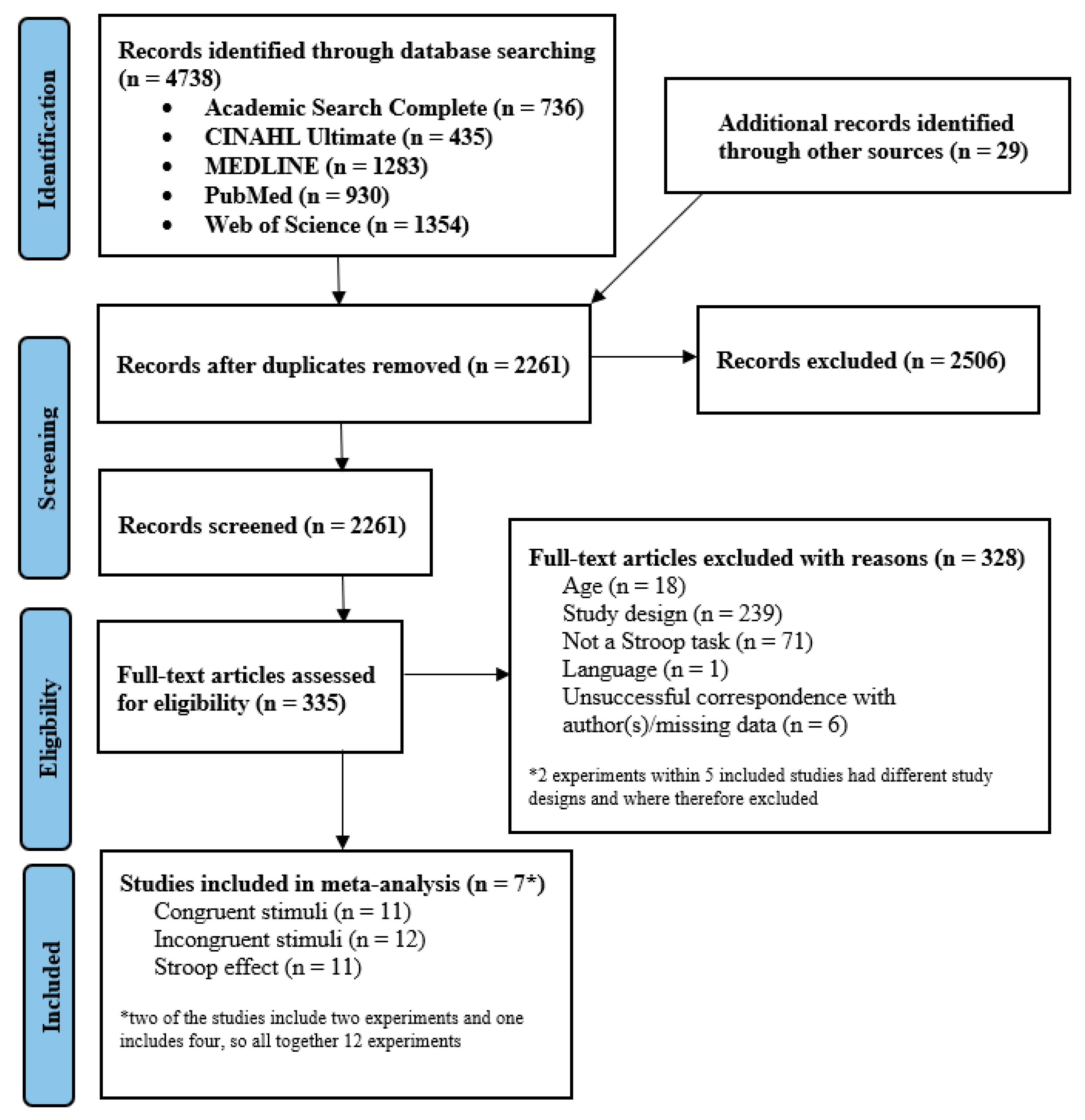
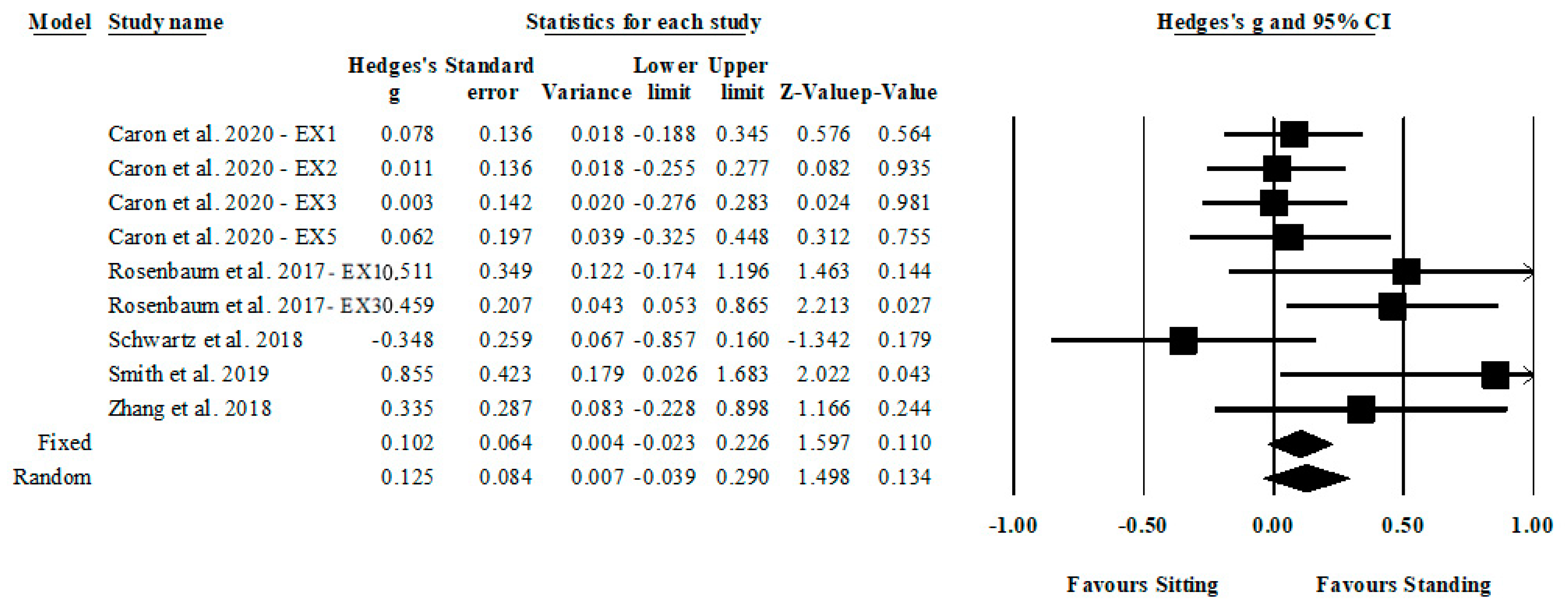
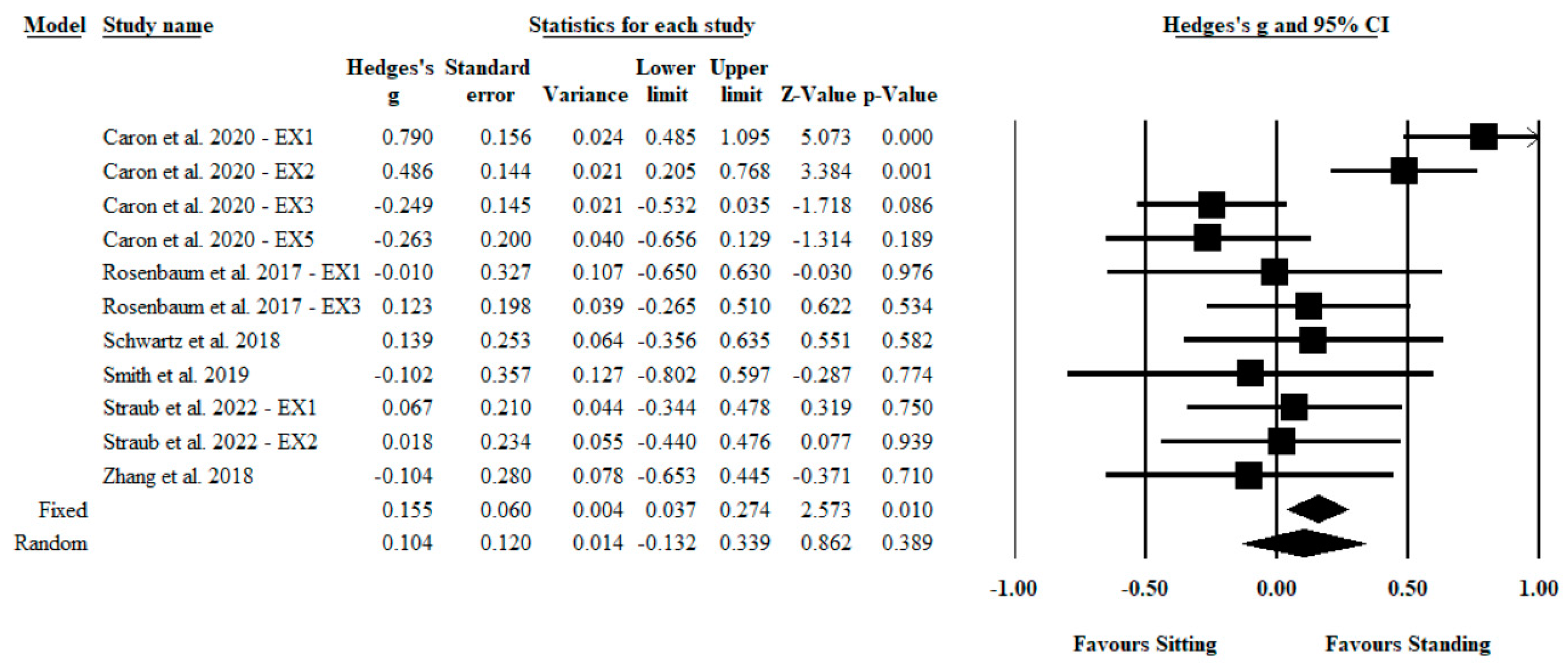
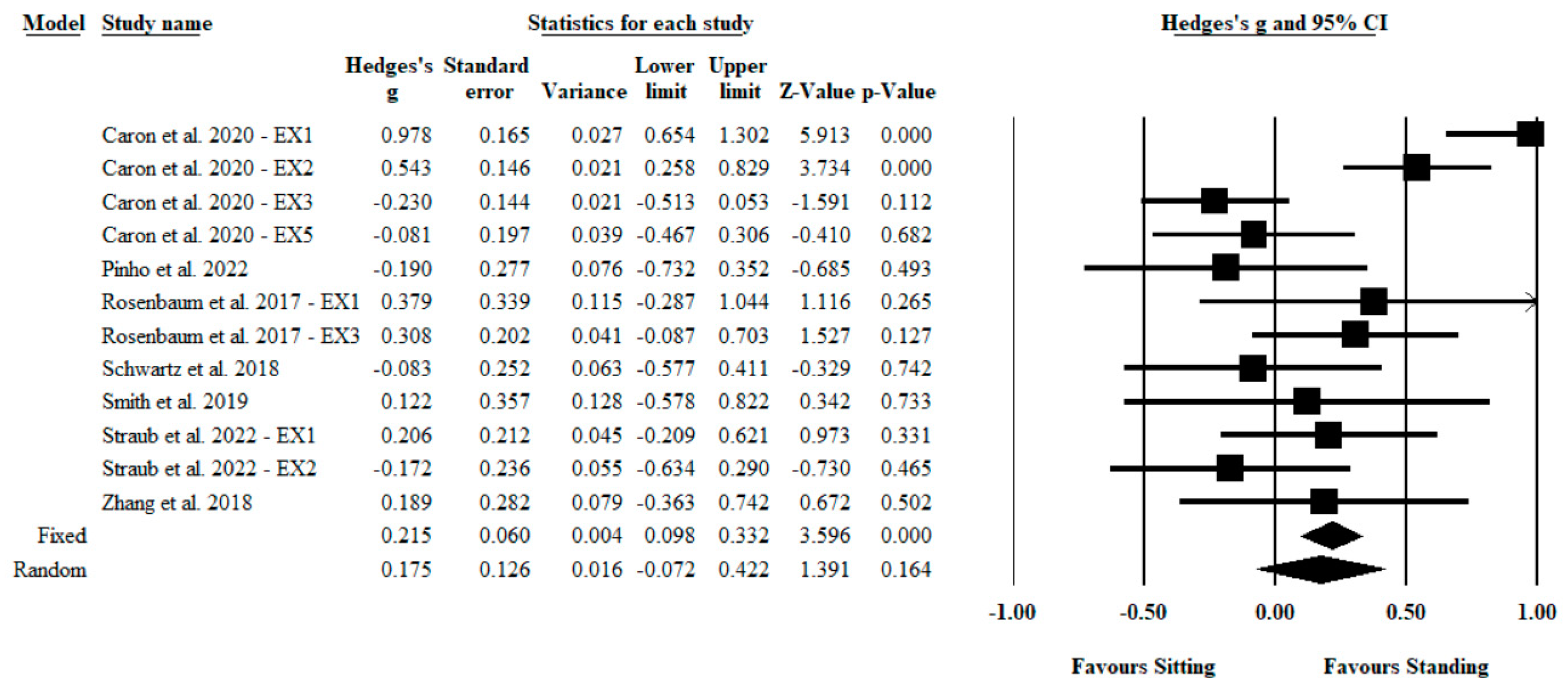
| Study | Experiment | Quality Criteria | Quality Score | Remark | |||||||||||
|---|---|---|---|---|---|---|---|---|---|---|---|---|---|---|---|
| a | b | c | d | e | h | i | j | k | l | m | n | ||||
| Rosenbaum et al. (2017) [28] | EX1 | x | x | (x) | (x) | x | (x) | x | x | x | x | (x) | x | 8 | c: undergraduate students; d: no information regarding participants’ gender and health condition (only vision was reported); h: no description of when and how the RTs were extracted specifically; m: no report of the Stroop effect (M ± SD) |
| EX3 | x | x | (x) | (x) | x | (x) | x | x | (x) | x | (x) | x | 7 | c: undergraduate students; d: no information regarding participants’ gender and health condition (only vision was reported); h: only a reference is made to EX1; k: no report of SD, CI, or variation of any kind for the congruent and incongruent stimuli; m: no report of the Stroop effect (M ± SD) | |
| Schwartz et al. (2018) [16] | x | x | (x) | x | x | (x) | x | x | (x) | x | (x) | x | 8 | c: undergraduate students; h: no description of when and how the RTs were extracted specifically; k: no report of the M and SD for congruent and incongruent stimuli (the data from the alternating condition was requested separately for sitting and standing); m: no report of the Stroop effect (M ± SD) | |
| Zhang et al. (2018) [36] | x | x | (x) | x | x | (x) | (x) | x | x | x | (x) | x | 9 | c: undergraduate students; h: no description of when and how the RTs were extracted specifically; i: small sample size; m: no report of the Stroop effect (M ± SD) | |
| Smith et al. (2019) [13] | x | x | (x) | (x) | x | x | (x) | x | x | x | (x) | x | 8 | c: undergraduate students; d: no information regarding participants’ gender and health condition; i: small sample size, although they reference Rosenbaum et al. (2017) saying that the sample size is similar; m: no report of the Stroop effect (M ± SD) | |
| Caron et al. (2020) [29] | EX1 | x | x | (x) | (x) | x | (x) | x | x | x | x | (x) | x | 8 | c: undergraduate students; d: no information regarding participants’ gender and health condition (only vision was reported); h: no description of when and how the RTs were extracted specifically; m: no report of the SD of the Stroop effect (M ± SD) |
| EX2 | x | x | (x) | (x) | x | (x) | x | x | x | x | (x) | x | 8 | c: undergraduate students; d: no information regarding participants’ gender and health condition (only vision was reported); h: no description of when and how the RTs were extracted specifically; m: no report of the SD of the Stroop effect (M ± SD) | |
| EX3 | x | x | (x) | (x) | x | (x) | x | x | x | x | (x) | x | 8 | c: undergraduate students; d: no information regarding participants’ gender and health condition (only vision was reported); h: no description of when and how the RTs were extracted specifically; m: no report of the SD of the Stroop effect (M ± SD) | |
| EX5 | x | x | (x) | (x) | x | (x) | x | x | x | x | (x) | x | 8 | c: undergraduate students; d: no information regarding participants’ gender and health condition (only vision was reported); h: no description of when and how the RTs were extracted specifically; m: no report of the SD of the Stroop effect (M ± SD) | |
| Straub et al. (2022) [30] | EX1 | x | x | (x) | (x) | x | (x) | x | x | x | x | (x) | x | 8 | c: undergraduate students; d: no information regarding standard deviation in age and health condition; h: no description of when and how the RTs were extracted specifically; m: no report of the Stroop effect (M ± SD) |
| EX2 | x | x | (x) | (x) | x | (x) | x | x | x | x | (x) | x | 8 | c: undergraduate students; d: no information regarding standard deviation in age and health condition; h: no description of when and how the RTs were extracted specifically; m: no report of the Stroop effect (M ± SD) | |
| Pinho et al. (2022) [37] | x | x | (x) | x | x | (x) | (x) | x | x | x | x | x | 9 | c: only women were included in this study and in the group of younger women there are only very young women, presumably students as the study was performed in the university setting; h: no description of when and how the RTs were extracted specifically; i: small sample size | |
| Experiments within Study | Study Aims | Participants (N, Age (M), Age (SD/Range), Sex) | Measures and Study Design | Exposure Duration | Outcome | Findings |
|---|---|---|---|---|---|---|
| Rosenbaum et al. (2017): EX1 [28] | Effect of sitting vs. standing on Stroop performance | N = 17, M = 23 y, age range = 19–27 y, n.a. | In the Stroop task, the stimuli were the color words “RED”, “GREEN”, “BLUE”, “BROWN” combined factorially with the corresponding print colors. The stimuli were generated in Microsoft Word and displayed on a light gray background on a 14-inch color monitor. Viewed from a distance of approximately 60 cm, participants responded by speaking into a microphone the name of the print color in which the words appeared. During both conditions, sitting and standing, participants were presented with 72 color-word Stroop stimuli, half congruent, half incongruent. The order of testing between sitting and standing was counterbalanced randomly across participants. | n.a. | RT, PE | Decrease in the Stroop effect when participants were standing. |
| Rosenbaum et al. (2017): EX3 [28] | N = 50, M = 26.1 y, age range = 19–32 y, n.a. | The stimuli and design were the same as in EX1. | n.a. | Decrease in the Stroop effect when participants were standing; ruled out the absolute RT as the factor generating the difference in selectivity between the standing and sitting conditions. | ||
| Schwartz et al. (2018) [16] | Effect of alternating postures on cognitive performance for healthy people performing sedentary work | N = 30, M = 25.3 y, SD = 3.8 y, 14 women | A digital Stroop test containing 190 congruent, incongruent and neutral (i.e., four crosses “XXXX” written in different colors) items were used. Text editing task and d2R test were also used. Reaction time and working speed were measured and recorded automatically using the software. For the intervention arm, the battery blocks were executed in alternating postures (sit-stand-sit-stand-sit) and for control periods (non-intervention day), all five battery trials were conducted in a sitting posture (sit-sit-sit-sit-sit); cross-over design. | 8–10 min (the whole block app. 30 min); a fixed 5-min break occurred between successive batteries | RT | No significant difference in the Stroop task between standing and sitting trials was found. |
| Zhang et al. (2018) [36] | Impact of the use of active workstation on executive function | N = 24, 12 men: M = 24 y, SD = 1.5 y, 12 women: M = 22.1 y, SD = 1.5 y | In the Stroop task, there were six kinds of trials: 1) the word “red” printed in red ink, 2) the word “blue” printed in blue ink, and 3) the word “green” printed in green ink, which was regarded as a congruent condition, and 4) the word “red” printed in blue or green ink, 5) the word “blue” printed in red or green ink, and 6) the word “green” printed in red or blue ink, which was regarded as an incongruent condition. Each stimulus was presented at 2000 ms and between two stimuli was 2 to 8 s interval with the sign “+” presented on the screen. Participants were required to tell the color name of the words by pressing corresponding buttons on the keyboard. N-back test and more-odd shifting task were also used. There were 96 color-word Stroop stimuli, half congruent and half incongruent. Each participant performed a test battery under each of four conditions, including sitting, standing, walking at an active workstation with self-selected speed (self-paced walking), and walking at an active workstation with 1.5 times the self-selected speed (faster walking). The order in which participants performed the experimental conditions was counterbalanced. | n.a. (the whole block app. 25 min); there were 2 min intervals between each task | RT, PE | The Stroop task performance did not vary across four workstation conditions. |
| Smith et al. (2019) [13] | Replication of the findings of Rosenbaum et al. (2017) | N = 14, undergraduate students, n.a. | In the Stroop task, there were three kinds of letter strings: 1) congruent strings spelled color-words that were consistent with the color in which they appeared (e.g., “RED” appearing in red), 2) incongruent strings spelled color-words that were inconsistent with the color in which they appeared, but consistent with the alternative response (e.g., “RED” appearing in green), 3) neutral strings consisted of a series of Xs (three or five Xs long to match the lengths of the strings “RED” and “GREEN”) in red or green. For all three kinds of letter strings, green and red strings were presented equally often. All stimuli were presented on an LCD flat-panel display on a black background. There was a 1500 ms inter-trial interval with a white fixation cross presented at the center of the screen in-between trials. Participants indicated their response by pressing the corresponding response button and they heard an error tone if they pressed the wrong button or did not respond within 1500 ms. Participants performed one-half of the experiment in each posture, sitting and standing, with posture order counterbalanced across subjects. For each posture, there were two initial blocks of practice trials, followed by four blocks of experimental trials. Each block (practice and experimental) consisted of 12 neutral, 12 congruent, and 12 incongruent trials for a total of 144 experimental trials in each posture. There was a brief break between blocks. | 30 min | RT, PE | The magnitude of Stroop interference was markedly reduced when participants adopted a standing posture; there was no main effect of posture, suggesting that the mild postural control requirements associated with standing enhanced attentional selectivity with no apparent cost. |
| Caron et al. (2020): EX1 [29] | Replication and extension of the findings of Rosenbaum et al. (2017) | N = 107, undergraduate students, n.a. | The Stroop task consisted of congruent stimuli (the uppercase words “RED”, “GREEN”, “BLUE”, and “BROWN”, each presented in their matching hue), incongruent stimuli (included all other combinations of the color words and hues), and neutral stimuli (consisted of colored strings of three to five Xs matched to the number of letters in the four-color words). The stimuli were displayed on a desktop PC on a light gray background. On each trial, the letter string appeared for 2000 ms, after which it was replaced by a gray screen for 2000 ms. Vocal responses were collected using a noise-canceling microphone. The experiment consisted of one block of 48 practice trials followed by two blocks of 108 experimental trials (36 congruent, 37 incongruent, 36 neutral, with 9 repetitions of each hue). One experimental block was performed sitting and the other standing. The order of posture conditions was counterbalanced across participants. | n.a. | RT, PE | The Stroop effect was smaller when participants were standing than when sitting but only for participants who started in the sitting posture. |
| Caron et al. (2020): EX2 [29] | N = 107, undergraduate students, n.a. | The stimuli and design were the same as in EX1, with three exceptions: (1) there were 24 practice trials before the initiation of both the sitting and standing condition, (2) there were only congruent and incongruent trials (no neutral trials), and (3) the number of trials in each condition was increased to 60. | n.a. | The Stroop effect was smaller when participants were standing than when sitting but only for participants who started in the sitting posture. | ||
| Caron et al. (2020): EX3 [29] | N = 97, undergraduate students, n.a. | The Stroop task consisted of color words “RED”, “YELLOW”, “BLUE”, and “GREEN” in colors for red, yellow, blue, and green, respectively. The stimuli were displayed on the E-Prime. Each trial began with a fixation cross in the center of the screen for 500 ms followed by a blank screen for 500 ms. The target display was then presented and remained on the screen until a response was made. Feedback was displayed when an error was made. Feedback was provided on incorrect trials. Responses were collected with a keyboard held vertically to the chest in both conditions. The experiment consisted of two blocks of 88 color-word Stroop stimuli, half congruent, half incongruent. One experimental block was performed sitting and the other standing. The order of posture conditions was counterbalanced across participants. | n.a. | The Stroop effect was smaller when participants were standing than when sitting but only for participants who started in the sitting posture. | ||
| Caron et al. (2020): EX5 [29] | N = 50, undergraduate students, n.a. | The stimuli and design were the same as in EX1, with four exceptions: (1) there were no practice trials, (2) the number of trials in each condition was increased to 72, (3) on each trial, the letter string appeared and remained on the screen until a response was made, after which it was replaced by a gray screen for 1000 ms before the stimulus for the next trial was presented, and (4) vocal responses were collected using a voice key (connected to a microphone). | n.a. | Responses for a given posture were faster when they were in Block 2 than in Block 1 (see Supplementary Material of the study [29]). https://osf.io/8h52v/ | ||
| Straub et al. (2022): EX1 [30] | Replication of the findings of Rosenbaum et al. EX1 (2017) | N = 44, M = 25.8 y, SD = n.a., 30 women | The Stroop task consisted of four different colors (green, red, blue, yellow) in which the carrier words (“GRÜN”, “ROT”, “BLAU”, and “GELB”, respectively) written in German in capital letters were presented against a black background. Stimuli were either congruent (e.g., “GRÜN” written in green) or incongruent (e.g., “GRÜN” written in yellow). Congruency was manipulated trial-wise with an equal proportion of congruent and incongruent stimuli. The stimuli were displayed on the E-Prime. A trial consisted of the presentation of a target stimulus that remained on the screen for 2000 ms or until a response was registered, followed by an inter-trial interval of 500 ms. Responses were collected manually. Error feedback was presented (for 500 ms) when participants pressed the wrong key or did not respond within the given response window. Before the experiment started, participants completed a training session with 20 trials in the posture they were assigned to start with. Participants completed one block with 144 trials in one posture and then changed the posture to complete another block in the other posture. The experiment consisted of four blocks with 576 trials in total. The order of posture was counterbalanced across participants. | n.a. | RT, PE | Did not confirm the hypothesis that the Stroop effect differs between standing and sitting posture. |
| Straub et al. (2022): EX2 [30] | Replication of the findings of Rosenbaum et al. EX1 (2017) | N = 38, M = 23.47 y, SD = n.a., 30 women | Each trial started with a fixation cross presented on the screen for 500 ms, followed by a color word (i.e., “GRÜN” or “ROT”) or neutral letters that consisted of a series of three or five Xs matched to the number of letters in the two color words presented in either green or red. Congruency was manipulated trial-wise with an equal proportion of congruent and incongruent stimuli. There was a 1500 ms inter-trial interval before the next fixation cross occurred. Responses were collected manually. An error tone was presented if participants pressed the wrong key or did not respond within 1500 ms. Each condition of posture started with two training blocks followed by four blocks of experimental trials. Each block comprised 12 neutral, 12 congruent, and 12 incongruent stimuli resulting in 36 trials per block and a total of 144 experimental trials per posture. The order of posture was counterbalanced across participants. | n.a. | RT, PE | Did not confirm the hypothesis that the Stroop effect differs between standing and sitting posture. |
| Pinho et al. (2022) [37] | To study the effects of a sensory aid (a light touch) on a dual-task paradigm and to understand the different responses on balance that were due to aging. | N = 25 women, M = 24.2 y, SD = 4.0 y, (also 25 older women were included (M = 67.3 y, SD = 4.2 y)) | Only incongruent stimuli were used (color and word font differ). Four different colors were used (red, blue, black, and green) and twelve sequences of six capitalized letters words were previously established in a randomized and balanced order (one for each condition with the Stroop test and three extras if it was necessary to repeat a trial). The sequence began with an alert symbol (+) indicating that the test would begin in 10 s. Then, the word appeared and remained in the projection for 3 s each. Each time a new word was projected, a beep was played to synchronize the participant’s answer and the stimuli onset. A microphone was used to register the participants` performance. Participants performed in a random and balanced order three trials of each condition (seated, quiet standing balance, quiet standing balance with haptic input via light touch, quiet standing balance with Stroop test, quiet standing balance with Stroop test and with haptic input via light touch) with a rest interval of 60 s between trials. | n.a. | RT, PE | Young adults showed reduced reaction time than older adults. The reaction time in correct answers did not differ between conditions. No differences between conditions were found for the reaction time of wrong answers. |
Disclaimer/Publisher’s Note: The statements, opinions and data contained in all publications are solely those of the individual author(s) and contributor(s) and not of MDPI and/or the editor(s). MDPI and/or the editor(s) disclaim responsibility for any injury to people or property resulting from any ideas, methods, instructions or products referred to in the content. |
© 2023 by the authors. Licensee MDPI, Basel, Switzerland. This article is an open access article distributed under the terms and conditions of the Creative Commons Attribution (CC BY) license (https://creativecommons.org/licenses/by/4.0/).
Share and Cite
Šömen, M.M.; Peskar, M.; Wollesen, B.; Gramann, K.; Marusic, U. Does Standing Up Enhance Performance on the Stroop Task in Healthy Young Adults? A Systematic Review and Meta-Analysis. Int. J. Environ. Res. Public Health 2023, 20, 2319. https://doi.org/10.3390/ijerph20032319
Šömen MM, Peskar M, Wollesen B, Gramann K, Marusic U. Does Standing Up Enhance Performance on the Stroop Task in Healthy Young Adults? A Systematic Review and Meta-Analysis. International Journal of Environmental Research and Public Health. 2023; 20(3):2319. https://doi.org/10.3390/ijerph20032319
Chicago/Turabian StyleŠömen, Maja Maša, Manca Peskar, Bettina Wollesen, Klaus Gramann, and Uros Marusic. 2023. "Does Standing Up Enhance Performance on the Stroop Task in Healthy Young Adults? A Systematic Review and Meta-Analysis" International Journal of Environmental Research and Public Health 20, no. 3: 2319. https://doi.org/10.3390/ijerph20032319
APA StyleŠömen, M. M., Peskar, M., Wollesen, B., Gramann, K., & Marusic, U. (2023). Does Standing Up Enhance Performance on the Stroop Task in Healthy Young Adults? A Systematic Review and Meta-Analysis. International Journal of Environmental Research and Public Health, 20(3), 2319. https://doi.org/10.3390/ijerph20032319







